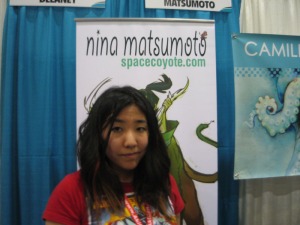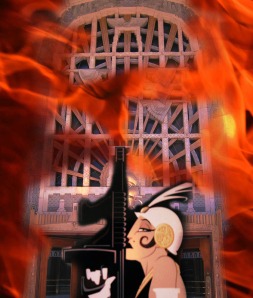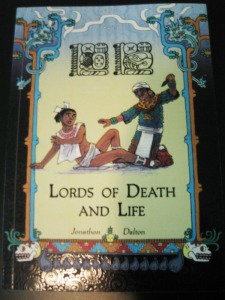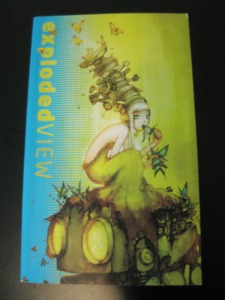Author Archives: Caroline Cryonic
Adarna SF is undead undead undead…
Adarna SF had been on hiatus since April 2012. My apologies to the authors whose books I read but didn’t review (MeiLin Miranda, Isa KFT… sorry!).
Yes, this is Frida writing. I have changed my pseudonym from Frida Fantastic to Caroline Cryonic. This is because my real name is indeed Caroline, and it’s easier to bridge my real life self and online persona that way.
Back to the hiatus. What happened was that I got burnt out from book reviewing, had other life priorities, and just lost interest in general. I think I’m ready to get back into blogging, although things will be different. The focus will still be on speculative fiction, ebooks, and indies but I’ll mix it up with other kinds of content, primarily of the geeky persuasion. We’ll see how it goes.
I’m moving from Vancouver, Canada to live in Metro Manila, Philippines for one year. I’m really interested in promoting Philippine speculative fiction and meeting the local authors. There are plenty of publications available as ebooks, so expect to see me blog about them. Speaking of Metro Manila, does anybody know of a writing workshop or group that I could join?
Anyway, I will leave you now with the opening sequence to a 1983 vampire flick, The Hunger, just because.
Frida explains her absence, then disappears into a puff of magic purple smoke
Hoo boy, I’ve been MIA since April 2012. Yeah, there’s been lots going on in my life: moving, job searching, etc. which is why Adarna SF has dropped down from my priority list. I can’t say my life is settled enough yet for me to have a regular reviewing schedule, so I’m mostly-on-hiatus as a reviewer. I want Adarna SF to keep chugging along as a review site though, so I’ll see if I can find more contributors.
If any of you Vancouverites are free this Saturday night October 20, I’ll be attending an event at the Rhizome Cafe from seven onward: “Six Queer Artists for Six Years of Rhizome: Gathering Spaces, Queering Places”. There’s an awesome line-up, but a guest of note is Japanese-Canadian writer, Hiromi Goto. I haven’t read any of Hiromi’s books, but I know of her through her insightful blog posts about cultural perspectives and appropriation in speculative fiction, which are highly recommended reading for writers and analytical readers out there. I’ll respond to shouts of “FRIDDAAAAAA” if you’re not afraid to make such shouts in public.
On another topic, I’d like to mention a brave little girl named Phoenix.
She was almost five years old, battled leukemia like a warrior, and was growing up to be a superhero. I attended her funeral last night–I didn’t know her well, but she’s a family member of several people who are close to me. As a friend of mine put it, this fire bird has transcended her physical bounds, but she will be sorely missed.
Rest in power, Nenix.
Checking out the city’s first major comicon at Fan Expo Vancouver
 As a sci-fi/fantasy geek in Vancouver B.C., I’ve envied the conventions that take place in the rest of North America.
As a sci-fi/fantasy geek in Vancouver B.C., I’ve envied the conventions that take place in the rest of North America.
We have some small scale events here, but they’re pretty low-key and mostly entail browsing through the stock of the local comic book stores. I like them, but I’ve also been craving the big con experience, along with the cosplays, chaos, and big media consumerism. I finally had a taste of it at first Fan Expo Vancouver.
It took place this past weekend, April 21-22, at the Vancouver Convention Centre. The line-up outside was insane, eventually spanning several blocks. I purchased my ticket in advance, so I was able to go inside immediately, but even then, it still took 45 minutes of lining up inside. It was that packed.
Damn, there were a lot of geeks, so many that I’m sure that many were from outside of Metro Vancouver. The scifi/fantasy media represented were mostly film, TV shows, video games, and comic books. Guests included the original Batmobile, Adam West & Burt Ward (Batman), Kevin Sorbo (Hercules, Andromeda), Marina Sirtis & Michael Dorn (Star Trek: Next Generation), and Kristin Bauer (True Blood). Canadian author Spider Robinson was pretty much the only one repping SF literature. But where was Vancouver homeboy, William Gibson? Perhaps cons aren’t his thing.
Comic artists/writers included Pia Guerra (Y The Last Man), Greg Rucka (The Punisher), and Whilce Portacio (The Hulk, and he’s Filipino-American). English voice actors represented the anime area (none of which I recognize, not my scene, although Anime Revolution hosted some panels), and several folks behind ReBoot were there.
Just some quick background–ReBoot is a 3d animated series from the 1990s, and a favourite amongst many Canadians of my generation. It was the first of its kind and produced from Vancouver, paving the way for the city’s animation industry. Unfortunately, I’ve never seen a single episode. What the heck was I doing back then? I think I was watching Cybersix and reading Dragonlance. Anybody have episodes to lend? I need to fill the hole in my Vancouver geek cred, quick.
I also had a nice chat with comic artist/writer, Nina Matsumoto, i.e. Space Coyote. She’s most well-known for her comic art for The Simpsons. She also illustrated the comic prequel to the Last Airbender film and is the creator of Yōkaiden, an original English manga published through Del Ray.
I actually haven’t read any of her more recent work, because I knew her from her Saturnalia webcomic, before she became famous with her Simpsons art. She’s busy with the Simpsons series, but she said that if she were to return to Saturnalia, she’d like to work on a prequel. Nina is also a Vancouver-based artist. She went to a high school that I know several people from, and we also went to the same art school, but at different times.
My favourite part of Fan Expo was the Artist Alley, checking out the goods by local comic artists. I read indie SF literature all the time, but what about indie SF comics? It’s a scene I’d like to explore further. I procured some merch to facilitate further research.
My research materials into the Canadian comic scene consists of two fancy comic books, and one badass print of a flapper with a Tommy Gun. Awesome. Oh yes, apologies for the bad photo quality. Despite the fact that I am part Frida Kahlo and part cyborg, I still use a Nikon point and shoot from 2005, and I don’t have Instagram pro skills. Consider these previews of the real thing.
My photo doesn’t do this art print justice but I swear, it’s gorgeous. I don’t think this lady is in a comic, but she should be. She’d probably fit into Art-Deco-Noir Strange Aeons webcomic. But yes, this print is made by Craig Wilson, who is a Vancouver comic artist man of mystery, who probably likes snowboarding or storyboarding because his online pseudonym is BoardGuy, but that’s all I could find out about him. Craig, where I can I find the rest of your stuff outside of your blog? Do you have an online shop? When’s your next con appearance? And if you’re reading this, can you please make a 1930s action comic where the ladyfolk are armed to the nines? You can collaborate with Jordan Boos of Strange Aeons, or compete against him, I don’t care! I need to see that flapper in an action sequence set inside the Marine Building, and causing the whole thing to collapse unto itself and burst into flames.
Next up is Lords of Death and Life, a Mesoamerican historical fantasy comic by Jonathon Dalton.
Jonathon lives in Abbortsford (a city just outside of Metro Vancouver) and he has some ongoing free webcomics on his website. I browsed through them and he seems into historical fantasy set outside of the usual European/Western tradition, and I completely approve.
This was the first time I’ve seen his work, but the premise and the beautiful artwork drew me in.
You can’t really read it, but this is what it says:
Imagine a world with powerful empires, huge cities built on trade, and three thousand years of recorded history, but one in which even the wheel doesn’t exist. It is a world where heroes step in and out of legend and magicians transform themselves at will.
Mol Kupul lives in this world. When he travels to the city of Xicalango in search of someone to interpret his strange dreams, he instead finds trouble brewing between the city’s Mayan and Aztec populations, and supernatural forces at work beyond his worst nightmare.
And with some commentary from Scott McCloud:
Jonathon Dalton’s Lords of Death and Life is an intoxicating fusion of ancient design and modern imagination. A fresh and enjoyable read.
Between those is a scene of a lone person wandering though the underworld, and beyond him is a skeleton with a spear to the skull–sold. I can’t wait to read it. If you can’t wait either, you can purchase the paper book from one of the listed retailers on Jonathon’s website, or as an ebook on The Illustrated Section and Graphicly.
Last but not least is Exploded View, a sci-fi comic anthology from the Vancouver-based Cloudscape Comics.
I’ve never read a comic anthology before, but it has stories from 25 different creators, so that should be interesting.
Dialogue from Aquanaut Zero by John Christmas:
“Government issued sake sucks. It’s the first thing you learn in Aquanaut training. This still hasn’t stopped Takashi from complaining about it. We’re explorers on imperial science vessel 00119 on a mission to the heart of the ocean.”
And Takashi behind him shouts, “My dog drinks better sake!”
You can buy the ebook and paper copy at the Cloudscape Comics store.
If you Vancouver folk want more comiccon action, there’s the Calgary Comic & Entertainment Expo next weekend from April 27 to 29 (only a 13 hour roadtrip!) and the Vancouver Comic Arts Festival (VanCAF) from May 26 to 27 (a Skytrain ride away). The latter takes place at the Yaletown Roundhouse and it’s free to attend. I’m totally going to VanCAF. By then I’ll be caught up with my ebooks and comics, and ready to take on more.
I found out all about this awesomeness through Fan Expo Vancouver. So let’s do it all again next year! What say you?
Generation by William Knight (2011)
 (Smashwords not available) / Amazon / Author’s Site
(Smashwords not available) / Amazon / Author’s Site
2/5 stars
Description:
Journalist Hendrix ‘Aitch’ Harrison links bodies stolen from a renowned forensic-research lab to an influential drug company. Aided by Sarah Wallace, a determined and beguiling entomologist, he delves into a grisly world of clinical trials and a viral treatment beyond imagining. But Aitch must battle more than his fear of technology to expose the macabre fate of the drugged victims donated to scientific research.
In 2001, scientists isolated the gene for regenerating damaged organs from the DNA of a South American flatworm. Within five years it had been spliced into the chromosomes of a rhesus monkey, transported through the cell walls by a retro-virus denuded of its own genetic material. Attempting to regrow impaired or elderly tissues, a scientist will one day modify the DNA of human beings by injecting the gene-carrying virus. It is just a matter of time.
Before consenting to treatment, you may want to ask a simple question: could there be a situation in which you would want to die but were unable to do so?
Review:
Generation pitches itself as a “crime-thriller with an injection of horror” and “The Girl With The Dragon Tattoo meets the X-Files.” That’s an accurate description of the concept, but not of the quality.
Hendrix Harrison, the protagonist, is a British Mikael Blomkvist with Fox Mulder’s interest in the paranormal, and he uncovers a conspiracy surrounding an experimental drug treatment that turns its test subjects into the living dead. The concept is intriguing, and I was hooked by the prologue and the body horror. I love my body horror and Knight knows how to write it excellently.
A row of teeth ran alongside a swollen tongue and Hendrix tried to discern where the tongue ended and the lips began. Translucent red skin was stretched tight across the chin and one cheek providing a window on a network of black veins and white nervous tissue. It was a mass of putrescent flesh dripping onto the pillow, soaking into the sheets, and being washed down the drain every time Thora cleaned.
While many of the horror elements are good, Generation is not a solid thriller in its current form. The first 25% of the book is a massive infodump, and I would have stopped reading it if I didn’t commit to writing a review. Sometimes, a slow build-up to the conflict is effective in horror fiction (Voice by Joseph Garraty is an example, and that’s a five-star book), but in Generation, it’s simply tedium. There are scenes of boardroom meetings, corporate Powerpoint presentations, lonely meals in greasy pubs, long-distance drives to meet with leads that go nowhere… it felt like it was going exactly in that direction–nowhere. But it significantly improves as the story goes on, and it fully hits its stride at the 75% mark.
This would have been a leaner and meaner book if chapter 10 was the beginning, and the background info in previous chapters were included in subsequent scenes that moved the plot forward. The novel has potential but there needs to be more focus on what’s important.
There was an obligatory sex scene that took place without foreshadowing (out-of-character sex seems to be the domain of thrillers, no idea why), and it was awkward because it disrupted the momentum of the story. It happened during a race-and-chase portion of the plot where the protagonists could be gunned down. I read on while thinking “This is the last thing I care about!”, flipping through it with growing frustration, hoping that the scene wasn’t too long because I wanted to get back to the story. I apologize for being crude, but the experience can only be described as the “reader blueball”.
The prose itself is good, and I could tell that the author was an experienced writer, but likely not as experienced with fiction. Small mistakes litter the work: typos, awkward adjectives (“rain-coloured sky”), redundant sentences summarizing the previous paragraph, problems with compound words, and so on. I’m not a professional editor, and I focus on enjoying the story as reader, but the mistakes kept on taking me away from the story.
Some of the differences in compound words are likely a difference in British spellings (I’m a reader based in Canada), and I’ve reviewed books by other British writers, but none of these differences bothered me. I think it’s because the errors in this book kept on switching on my inner editor and I couldn’t help but scrutinize the most minor of details.
I didn’t warm up to the characters at first, I actually had trouble telling them apart because their characterizations were so bland. But I grew to like them and root for them once Big Pharma was out to tear them apart limb from limb. This happened midway through the book, and again, I wish it took place earlier.
Overall, Generation has its moments, and it has the foundations for a solid sci-fi/horror conspiracy thriller. Unfortunately, it’s not polished enough in its current form, but I hope there will be a re-edited version. Considering the major problems with story focus, pacing and infodumping, I’m not ready to read another full-length novel by this author. But Knight writes excellent body horror, so if he has some short horror fiction, I’d definitely be interested.
You might like this if you like…
A British Mikael Blomkvist with Fox Mulder’s interest in the paranormal; body horror; evil Big Pharma; conspiracy thrillers; zombies; near future sci-fi
William Knight is a British born journalist and technologist currently living and working in Wellington, New Zealand. In 2003 he published his first feature in Computing magazine and has since written about the many successes and failings of high-tech for the Guardian, Financial Times and the BBC among many others publications. He continues to maintain a lively IT consultancy.
April 23 update: I received an email from an author stating that the ebook available on Amazon is a recently edited version and a significant improvement over my review copy.
Quick Update on the Adarna SF Review Schedule
As you’ve noticed, we haven’t been following the Review Schedule recently. But please be assured that Chris has been reading the Alternative Alamat anthology, I’ve finished reading Generation by William Knight, and I’m in the process of reading Arcane.
We haven’t been updating as frequently since we’ve been busy with other projects. There’s been a lot of changes in my life last few months–I’ve graduated from university, taken on new volunteer work in the community, and face the usual flux that people in their early 20s tend to experience. Starting this book blog is one of the best things I’ve done, but it runs on our unpaid volunteer time (affiliate marketing for indie books doesn’t pay well…), and to stay passionate as speculative fiction fans we have to treat book reviewing like an awesome hobby. If we start treating it as work, we might devolve into jaded pseudo-editors, and that’s not cool.
Adarna SF is still active and we’re in it for the long-haul, we’re just adding the disclaimer that our Review Schedule dates are more approximate than definite. So readers, stay subscribed to our RSS feed or via email, and authors, keep submitting–we’re happy to get lost in your worlds!
Fistful of Reefer by David Mark Brown (2011)
 Smashwords / Amazon / Author’s Site
Smashwords / Amazon / Author’s Site
3/5 stars
Description:
In 1918, when Chancho Villarreal and his friends inadvertently create the legend of El Chupacabra, they draw the attention of Texas Ranger J.T. McCutchen to their goat ranch and marijuana farm north of Del Rio, Texas. What follows is an action-packed ride across the wilds of a Texas haunted by rumors of Chupacabras behind every bush.
This double-fisted, dieselpunk weird-Western resides between No Country for Old Men and The Three Amigos.
Review:
Fistful of Reefer has a killer premise. It’s a Weird West/dieselpunk adventure set in Texas about a gadgeteer genius Mexican marijuana farmer who’s on the run from a bordering-on-psychotic prohibitionist Ranger. It’s the first novel in the Reeferpunk series.
The opening scene sucked me in. Ranchers confront Chancho about their dead goats, and one reaches for his pistol and growls, “The goats didn’t die from demon curse or fright, they died from colic–from too much marihuana.” There are shootouts, chili-bombs, and epic chase scenes involving bales of marijuana. What more could one ask for?
The flippant prose is delightful in its old school pulp style, and the action sequences are thrilling. I’d probably re-read some of the fight scenes because they’re that awesome.
For a book that promotes itself as a dieselpunk adventure, there isn’t much dieselpunk machinery, although Chancho makes a pretty epic marijuana harvester that runs on manure. I hope Chancho displays more of his gadgeteer genius skills in the future.
I liked that the protagonists were a Mexican man, indigenous woman, and Black Seminole in a Weird West. But unfortunately, there’s a lot of forced sentiment regarding protagonists, but your mileage may vary. If you like the melodrama and romanticism found in old movies like María Candelaria, then it won’t bother you, but I found it to be dated and uncomfortably bridging on noble savage tropes with its cultural baggage (which requires taking its portrayals of indigeneity with a truckload of salt).
Characterization isn’t Fistful of Reefer‘s strong suit. Everyone can be summed up in two traits. They’re still charming in that pulp fiction way, but I wanted more depth in the protagonists. I still really like that they are the heroes in a Weird West, but I wish they were more often defined by their personality, with their background informing their point of view, rather than being almost nothing more than their background. The story should make it clear that Chancho is a loveable rogue because he’s Chancho, and not because he’s Mexican; Nena is a brave woman because she’s Nena, not because she’s of the Kickapoo people; and Muddy is loyal and dependable because he’s Muddy, not because he’s Black Semiole.
Pages of infodumping about the protagonists’ histories take away the story’s momentum. Along the same lines, there’s a lot of telling instead of showing with regards to their character traits. There’s a disconnect between what their traits are supposed to be, versus what they are actually doing in the story. I can’t say I’m impressed by the protagonists, but in contrast, the villain Ranger McCutchen is an excellent character. His motivations and history are revealed more naturally in smaller segments, and his actions speak for themselves. The narration didn’t have to tell me explicitly that he’s creepy and insane. He just is. This would be a much stronger book if the protagonists’ character traits were laid out in a similar manner.
Chancho’s aspirations grow larger towards the end of the book, instead of merely trying to outrun the ranger, he starts having loftier dreams of liberating the American people. Unfortunately, I was confused as to what this exactly meant. Does liberating the people mean liberating them from prohibition? Is it strictly about marijuana or is it more than that? Even though it’s not clear what Chancho stands for, people turn up in droves to support him, because the narration claims that he’s a Good Guy and stands for Good Things. So at the end of the book, I was left confused and unfulfilled.
Even though I have a number of criticisms with Fistful of Reefer, I commend the author for creating a fun and unique world, and I think that the series has promise.
You might like this if you like…
Weird West; race and chase scenes; liberation from prohibition; pulp fiction; sweet ganja
The sequel, The Austin Job, is now available on Amazon.
David Mark Brown has some free serialized novellas set in the same world. You can read them on his website under “Reeferpunk“.
Voice of the Lost by Andrea K. Host (2011)
 Smashwords / Amazon / Author’s Site
Smashwords / Amazon / Author’s Site
4/5 stars
Description:
Medair an Rynstar wants only to leave.
Five hundred years after the Empire she served fell before the Ibisian invasion, Medair has betrayed her Emperor’s memory by helping the descendants of the invaders. She knows she will be reviled, that to thousands she is hero-become-villain. Her one goal is to return to the hidden cave where she slept out of time, and hope that she wakes in a world where the name Medair an Rynstar has been forgotten.
Assassins, armies, and desperate magic complicate Medair’s plan of escape, leading her inexorably to face the very people her choice has cost the most. She has learned that you can never return to your past, or run from the consequences of your actions, but can she find a way to live in defeat?
Review:
Voice of the Lost is the perfect sequel to The Silence of Medair. The first book is a political fantasy that’s epic in scope, and Voice continues to develop the themes of colonialism, empire, and sacrifice and a controversial romance is set in motion. Medair chooses to side with the descendants of her invaders while facing an oncoming apocalypse brought on by wild magic. Talk about raising the stakes!
I loved this book, and it has the strengths of The Silence of Medair, but with a slightly different focus. It’s still character-driven, but there’s less brooding introspection and more political intrigues. Medair is thrust in the midst of a war and makes tough choices, possibly earning her place as a villain in history. What makes it interesting is how she deals with it, and how she views heroism, sacrifice, and ethics in herself and the colonizers. Medair’s character development is one of the best I’ve seen in the fantasy genre.
I must commend the author for how she handles magic in the world-setting. Magic systems are best explained in some books, while in others, it’s best left as a mysterious force of nature–whichever helps the suspension of disbelief. Höst treats it as the latter, and it works. Magic is a messy thing in this world–it merges parallel worlds, triggers a looming apocalypse, and even changes people’s ethnicity–which is a big deal in a historical reality of heated colonizer vs. colonized dynamics. While those are all crazy, its believable because the emotional consequences for the characters are so real, and that’s the key achieving verisimilitude in fantastical literature. I don’t know how the author pulled it off, but she deserves mad props.
With sacrifice as a key theme, it mostly reads like a tragedy. Whenever I cheered for the small victories, things became infinitely worse, but none of it came off as melodramatic. I was on the verge of tears in some parts, unable to decide whether it’s best to read on (and feel that screwdriver to the chest) or put the book down (and be unable to think of anything else!).
Medair’s internal dialogue sometimes summarizes what just happened and her reaction to it instead of only the latter, and it’s a little redundant. But other than that minor quibble, there’s nothing I’d change about the book.
It’s rare to find an epic fantasy that’s ambitious in scope and yet ties the story together succinctly. There’s no filler subplots or unnecessary scenes, it hits hard but ends with a satisfying conclusion. The story is emotionally involving and deals with heavy themes, but it’s worth it. I highly recommend this duology if you’re looking for an epic fantasy that’s character-driven, different, and thought-provoking.
You might like this if you like…
Epic fantasy with no filler; epic apocalyptic scenarios; fantastic character development; intelligent themes that you’ll ponder on long after you’ve read the book
If you’re interested in reading this two-book series, you can also purchase it as a single volume on Smashwords or Amazon. It’s a better deal than buying each book separately.
You can also read my interview with Andrea K. Host.




















